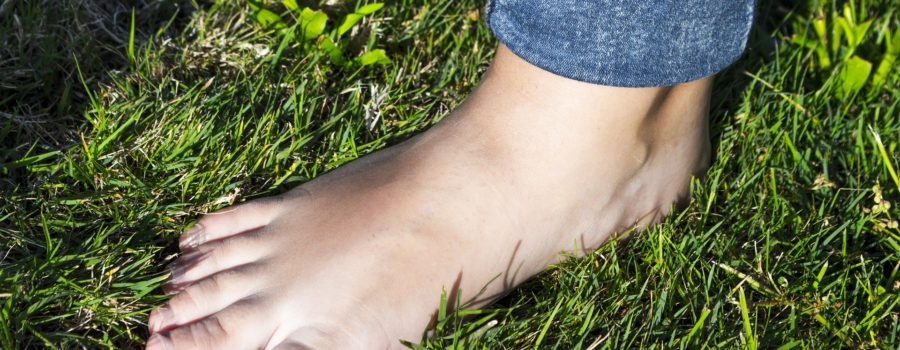What if I told you that there is one key practice that is absolutely vital for overall health and wellness, yet many people aren’t even aware of it?
Well, this lost practice is earthing.
Earthing
Earthing, or grounding, is simply coming into direct contact to the Earth with your bare feet or other body parts. It is truly one of the most primal, basic things one can do, but hardly anyone does it anymore.

The vast majority of people today are inside all day, never connected to the ground. And even when they’re outside, most people wear socks and insulated shoes, thus never coming into direct contact with the Earth.
This contrasts sharply with what we as humans had previously been doing for thousands of years. Humans used to walk barefoot and were connected with the Earth’s surface constantly. Even when they developed shoes, these were made of leather and still allowed direct contact between the earth and the body. Grounding wasn’t really a choice back then; it was just a byproduct of their way of life. Nonetheless, it still benefited them and contributed greatly to their health.
On the other hand, lack of grounding can have significant negative impacts on our health. In fact, lack of grounding is likely a major component in the current chronic disease epidemic. Unfortunately, as I said before, many people aren’t even aware that they should be doing this. Pair that lack of awareness with a society that is not conducive at all to going barefoot, and you have the perfect recipe for lack of earthing and, thus, suboptimal health.
You might be thinking, “really? How could something so (seemingly) trivial negatively affect our health that much?”
And I hear you. So, to understand this, it is essential to understand a little bit about the electrical charges around us.
Electrical Charges and Health
Every living thing has an electrical charge, down to the smallest possible level, at the atomic level and beyond. And all of these electrical potentials influence bioelectrical and bioenergetic processes.

Importantly, the Earth also has its own charge, which is a negative charge. The Earth’s surface is filled with a limitless supply of free electrons that it gives off to every living thing that comes into contact with it. In turn, this has the potential to restore, stabilize, or normalize the internal environment of all living things. In fact, earthing is seen as a universal mechanism for all living things in order to be at optimal health levels (1).
So, when we come into contact with the Earth, these electrons are transferred to our body which helps to balance out our own internal electrical charge, leading to a healthier internal state. Specifically, direct contact with the earth balances out our electrical potential and leads to healthier bioelectrical and bioenergetic processes (2).
“Earthing means a return to a forgotten and vital aspect of Nature – Earth’s healing properties – that has great potential to both prevent and treat common disorders afflicting modern society.”
(Menigoz, et al., 2020, p.160)
Earthing Deficiency and Chronic Health Problems
Without this contact, the body becomes deficient in electrons and can build up an overly positive electrical potential, which leads to a poorly functioning internal state and increases the risk for many chronic diseases.
And this is exactly what is happening to many people today. Without free electrons coming from the surface of the earth, many people are building up an excessively positively charged state. As a result, this is contributing greatly to many of the health issues plaguing society today.
For the specifics of these issues, read on below!
Pain and Inflammation Reduction
One of the earliest researched benefits of grounding, and still one of the most prominent benefits, is a reduction in pain and inflammation. When one is grounded, the electrons from the earth are transferred to the body, which then act as powerful antioxidants against free radicals and other inflammatory compounds. In turn, this leads to a dramatic reduction in the cardinal signs of inflammation, such as redness, swelling, pain, and heat (3).
This is very important because many people today suffer from chronic inflammation and excess free radical production, stemming from stress, poor diet, lack of movement, poor sleep, and so forth. So grounding is an essential practice in order to boost antioxidant levels and reduce inflammation. Studies have shown that grounding significantly reduces pain and is effective for acute and chronic inflammation (4) (5).
Immune Health
Furthermore, grounding appears to have positive effects on the immune system by altering white blood cell counts (such as neutrophils and lymphocytes) and other substances and chemicals involved in inflammatory and immune responses (3,5). The end result is that earthing leads to a much quicker recovery from injuries and a much better functioning immune system.
Exercise
These benefits are also seen for those who work out. Indeed, delayed-onset muscle soreness is dramatically reduced when individuals participate in earthing after a strength training workout; this is partly due to decreased inflammation and markers of muscle damage (6). Furthermore, for those who work out, earthing increases immune function and decreases pain, both of which lead to better recovery (7).
A Universal Healer
So, whether you suffer from chronic pain, inflammation, poor immune health, and/or muscle soreness, earthing is one of the best things you can do to reduce all of that! It truly should be implemented in all cases of pain, injury, and illness, and whenever one wants to recover as quickly as possible.
Nervous System and Endocrine System Regulation
There are also a number of ways that grounding improves endocrine and nervous system health, such as through improving sleep and mood and reducing stress.
Earthing acts a neuromodulator, in that the electrical charges generated help to regulate the nervous system (8). Electrophysiological effects also appear to take place in the brain when one is grounded to the earth. Specifically, significant changes in brain waves (as measure by EEGs) occur when earthing, suggesting an influence on the autonomic nervous system (9). In fact, grounding may be the most important regulator of the nervous and endocrine systems (10).
Nervous System Restoration
Furthermore, earthing leads to reductions in tension and stress in the muscles, as well as decreased blood pressure, and blood volume pulse (10,11). And, taken together, all of these things suggest that grounding helps the body switch over to a more parasympathetic state, which is a state of relaxation. Other studies have shown that grounding improves heart-rate variability and shows beneficial effects for blood oxygenation, skin conductance, and respiratory rates (12, 13) This again shows that grounding plays a large role in balancing the autonomic nervous system and reducing the stress response.
This is crucial because many people are in a constant state of sympathetic nervous system activation, which is the “fight-flight-freeze” state. This means that many people have constantly elevated heart rates, blood pressure, tension, and stress, both at a physical and psychological level, which eventually leads to burnout and potentially anxiety, depression, exhaustion, and many other problems.
And we are now starting to understand that a lack of grounding plays a huge role in this, in that it is essential for helping the body switch over to the parasympathetic state and thus balancing the nervous system.
Cortisol, Mood, and Sleep
Earthing also provides a number of benefits for sleep, mood, and other psychological factors.
For example, earthing also leads to significant improvements in mood. And these improvements go beyond what would be expected to occur in normal relaxation responses (14). This occurs in large part because earthing reduces cortisol which leads to less stress and more relaxation.
Studies on grounding and sleep show that this practice leads to a realignment of day-night rhythms, better sleep quality and greater sleep quantity, more energy, and potentially less irritability, stress, anxiety, and depression (15).
Improved Cardiovascular Health
Another major general benefit of grounding is improved cardiovascular health. When grounded, red blood cells in the body obtain a more negative charge, and this leads to increased spacing between the cells. In turn, grounding decreases blood clumping and viscosity and improves blood flow, all of which significantly decrease the risk for cardiovascular disease (17). Studies have also shown that grounding significantly improves blood flow and overall circulation in the body (18,19).
Relatedly, earthing is also able to significantly reduce blood pressure in individuals with prehypertension or those already with hypertension (20, 21). In turn, reduced blood pressure leads to a lower risk for all cardiovascular problems, such as strokes and heart attacks. And, in today’s society, the number of people with these conditions is dramatically increasing. Thus, grounding is an extremely simple way to help mitigate many problems plaguing people today.
Simple, yet Highly Beneficial
As you’ve seen from the above research, earthing offers many benefits to human health. This is simply because it involves reintegrating a lost practice that we have been doing naturally for thousands of years. It is often the simplest and most natural things that offer the most health benefits, and grounding is the epitome of that idea.
Just as we need food, water, sleep, and social connection for optimal health, the human body most definitely needs direct contact with the Earth to function at its highest level.
Implementation
Luckily, implementing this is very simple. For the cheapest and simplest way, simply find a place to go outside and walk around with your bare feet. Take a barefoot walk in the park; garden without shoes; or go to the beach! The latter is probably the most enjoyable way to ground. And with summer coming up, this is a great way to spend hours of time in direct contact with the Earth. (As a side note, more grounding during the warmer months is very likely one of the reasons people feel healthier and have more energy during the summer.)

The other option is to purchase grounding mats or pads and stand, sit, or sleep on them indoors. This option is obviously more expensive, but the overall cost is low. Ideally, this option would be your last resort, or something to do on days when you can’t get outside. I would never make this option your primary way to ground because, even though it simulates electrical contact, nothing can replace the effects of the actual Earth.
Whatever way you do it, aim to get at least 5 minutes of grounding per day. (Ideally, 30 minutes or more). The more, the better! There is no “overdose” on earthing.
Also, while you can do it any time of day, grounding is a particularly great thing to do first thing in the morning. There isn’t really a much better way to start your day by being connected to the Earth and watching the sun come up.
Reincorporating out Natural Ways
The practice might seem a little “far off” or eccentric, but when you really look at it, NOT grounding is the practice that’s weird and unnatural. It’s just because we’ve been so detached from it for so long that we seem a little confused or reluctant about it. But it truly is the way we’re meant to live, and once you start incorporating earthing into your life, you WILL notice many health benefits.
References
1. Sinatra, S. T., Oschman, J. L., Chevalier, G., & Sinatra, D. (2017). Electric nutrition: The surprising health and healing benefits of biological grounding (Earthing). Altern Ther Health Med, 23(5), 8-16. PMID: 28987038.
2. Menigoz, W., Latz, T. T., Ely, R. A., Kamei, C., Melvin, G., & Sinatra, D. (2020). Integrative and lifestyle medicine strategies should include Earthing (grounding): Review of research evidence and clinical observations. EXPLORE, 16(3), 152-160. Wendy MenigozTracy T. LatzRobin A. ElyCimone KameiGregory MelvinDrew Sinatra123
3. Oschman, J. L., Chevalier, G., & Brown, R. (2015). The effects of grounding (earthing) on inflammation, the immune response, wound healing, and prevention and treatment of chronic inflammatory and autoimmune diseases. Journal of Inflammation Research, 8, 83. 10.2147/JIR.S69656
4. Chevalier, G., Patel, S., Weiss, L., Chopra, D., & Mills, P. J. (2019). The effects of grounding (earthing) on bodyworkers’ pain and overall quality of life: A randomized controlled trial. EXPLORE, 15(3), 181-190. https://doi.org/10.1016/j.explore.2018.10.001
5. Amalu, W. (2004). Clinical earthing application in 20 case studies. Medical Thermography Case Studies. https://earthinginstitute.net/wp-content/uploads/2019/02/thermographycasehistories2004.pdf
6. Müller, E., Pröller, P., Ferreira-Briza, F., Aglas, L., & Stöggl, T. (2019). Effectiveness of grounded sleeping on recovery after intensive eccentric muscle loading. Frontiers in physiology, 10, 35. https://doi.org/10.3389/fphys.2019.00035
7. Brown, D., Chevalier, G., & Hill, M. (2010). Pilot study on the effect of grounding on delayed-onset muscle soreness. The Journal of Alternative and complementary Medicine, 16(3), 265-273. doi: 10.1089=acm.2009.0399
8. Sokal, P., & Sokal, K. (2011). The neuromodulative role of earthing. Medical hypotheses, 77(5), 824-826. 10.1016/j.mehy.2011.07.046
9. Chevalier, G., Mori, K., & Oschman, J. L. (2006). The effect of earthing (grounding) on human physiology. European Biology and Bioelectromagnetics, 2(1), 600-621. https://earthinginstitute.net/wp-content/uploads/2019/12/Effect-of-Earthing-on-Human-Physiology-Part-1.pdf
10. Chevalier, G., & Mori, K. (2007). The effect of earthing on human physiology Part 2: Electrodermal Measurements. Subtle Energies & Energy Medicine, 18(3), 11-34.
11. Sokal, K., & Sokal, P. (2011). Earthing the human body influences physiologic processes. The Journal of Alternative and Complementary Medicine, 17(4), 301-308. 10.1089/acm.2010.0683
12. Chevalier, G., & Sinatra, S. T. (2011). Emotional stress, heart rate variability, grounding, and improved autonomic tone: clinical applications. Integrative Medicine, 10(3), 16-21.
13. Chevalier, G. (2010). Changes in pulse rate, respiratory rate, blood oxygenation, perfusion index, skin conductance, and their variability induced during and after grounding human subjects for 40 minutes. The Journal of Alternative and Complementary Medicine, 16(1), 81-87. https://doi.org/10.1089/acm.2009.0278
14. Chevalier, G. (2015). The effect of grounding the human body on mood. Psychological reports, 116(2), 534-542. https://doi.org/10.2466/06.PR0.116k21w5
15. Ghaly, M., & Teplitz, D. (2004). The biologic effects of grounding the human body during sleep as measured by cortisol levels and subjective reporting of sleep, pain, and stress. Journal of Alternative & Complementary Medicine, 10(5), 767-776. https://doi.org/10.1089/acm.2004.10.767
16. Yum, B. S., Park, J. B., & Kim, K. Y. (2020). Effect of Earthing Mat on the Quality of Sleep. Journal of Environmental Health Sciences, 46(1), 103-109. https://doi.org/10.5668/JEHS.2020.46.1.103
17. Chevalier, G., Sinatra, S. T., Oschman, J. L., & Delany, R. M. (2013). Earthing (grounding) the human body reduces blood viscosity—a major factor in cardiovascular disease. The journal of alternative and complementary medicine, 19(2), 102-110. 10.1089/acm.2011.0820
18. Chevalier, G. (2014) Grounding the Human Body Improves Facial Blood Flow Regulation: Results of a Randomized, Placebo Controlled Pilot Study. Journal of Cosmetics, Dermatological Sciences and Applications, 4, 293-308. doi: 10.4236/jcdsa.2014.45039.
19. Chevalier, G. , Melvin, G. and Barsotti, T. (2015) One-Hour Contact with the Earth’s Surface (Grounding) Improves Inflammation and Blood Flow—A Randomized, Double-Blind, Pilot Study. Health, 7, 1022-1059. doi: 10.4236/health.2015.78119.
20. S Teli, S., Velou M, S., L, P., & D, D. (2015). An experimental Study on immediate effect of direct barefoot contact with earth on prehypertension. International Journal of Medical Research and Review, 3(8), 836-840. https://doi.org/10.17511/ijmrr.2015.i8.157
21. Elkin, H. K., & Winter, A. (2018). Grounding Patients With Hypertension Improves Blood Pressure: A Case History Series Study. Altern Ther Health Med, 24(6), 46-50. PMID: 30982019.




